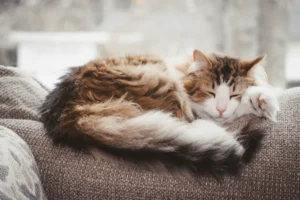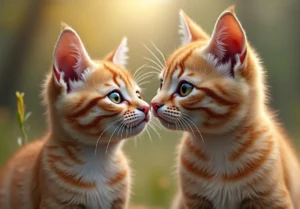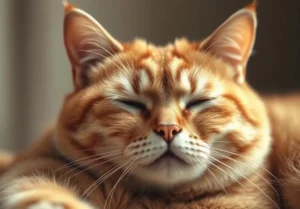Cats are known for their mysterious behavior, but one question that many cat owners have is: why are cats always in heat?
Cats go into heat for specific reasons, and understanding this behavior is essential for cat owners to provide the best care for their feline companions. Below is a detailed outline of why cats are always in heat and what you can do to help them.
Understanding the Heat Cycle
If you’ve ever wondered why cats seem to always be in heat, understanding their heat cycle is key. Typically, female cats experience heat cycles every two to three weeks, with each cycle lasting about a week. Signs to look out for include vocalization (such as loud yowling), increased affection, restlessness, and possible urine marking. During this time, your furry friend may seek attention more persistently and exhibit behaviors like rolling on the floor or presenting their hindquarters. It’s important to note that unspayed female cats can go into heat as early as four months old, so spaying is highly recommended to prevent these frequent cycles and unwanted pregnancies.
Reasons for Frequent Heat Cycles
There are several factors that can contribute to cats experiencing frequent heat cycles. One common reason is the presence of male cats in the area, as their pheromones can trigger a female cat to go into heat. Additionally, environmental factors such as changes in daylight hours and temperature can influence a cat’s reproductive cycle. Stress and health issues can also play a role in causing more frequent heat cycles in cats. Ensuring your feline companion is in a calm and healthy environment can help regulate their heat cycles. Remember, spaying your cat not only helps prevent overpopulation but also eliminates the stress and discomfort of frequent heat cycles for your furry friend.
Additional Unique Insight: Natural Breeds
Some cat breeds, like the Siamese and Burmese, are known to be more vocal and have more frequent heat cycles compared to other breeds. These natural breeds may require extra attention and care to manage their heat cycles effectively. If you have a cat of a specific breed known for these tendencies, be prepared for more frequent heat cycles and consider consulting with a veterinarian to address any concerns or behavior changes.
Best Practices for Managing Heat Cycles
Cats being in heat can be a handful, but there are ways you can help manage this natural process. To keep your feline friend content and comfortable, make sure they have plenty of opportunities to play and expend energy. Engaging toys and interactive games can help distract them during this time. Additionally, creating a calm and relaxing environment at home can reduce stress and anxiety. Providing a cozy spot for your cat to rest and relax can also help ease their discomfort. Remember, patience is key during this period.
Tips for managing your cat’s heat cycles: 1. Play with your cat regularly to keep them active and distracted. 2. Create a peaceful environment at home to reduce stress. 3. Provide a comfortable resting area for your cat. 4. Consider using pheromone products to help calm your cat. 5. Consult your veterinarian for further advice or support.
Medical Interventions for Cats in Heat
When things get too heated with your cat’s heat cycles, it may be time to consider medical interventions. Spaying or neutering your cat is a common and effective way to regulate their heat cycles and prevent unwanted litters. This procedure not only helps control their reproductive urges but also has numerous health benefits for your furry companion. If you’re unsure about this option, consult your veterinarian to discuss the best course of action for your cat’s specific needs.
Options for medical interventions: 1. Spaying or neutering your cat to regulate heat cycles. 2. Consulting your veterinarian for professional advice and guidance. 3. Exploring pheromone therapy options for behavioral support. 4. Considering temporary solutions like hormone injections. 5. Monitoring your cat closely and seeking help if needed.
Behavioral Changes During Heat Cycles
Have you noticed your feline friend acting a bit differently lately? Cats in heat may display some unique behaviors, like increased vocalization, restlessness, and rubbing against objects or people. They may also become more affectionate or even aggressive. To help address these behaviors, try providing extra playtime, interactive toys, and creating a calm environment. Additionally, consider spaying your cat to prevent future heat cycles.
Impact of Spaying and Neutering
Spaying and neutering your cat not only helps control the pet population but also benefits your furry companion’s health. Female cats who are spayed will no longer experience heat cycles, reducing the chance of unwanted pregnancies and potentially lowering the risk of certain reproductive cancers. Male cats who are neutered may exhibit fewer territorial behaviors and are less likely to roam or spray to mark their territory. So, consider spaying or neutering your cat not only for their well-being but also for your peace of mind.
Environmental Factors Influencing Heat Cycles
Cats are highly sensitive to their environment, and this can greatly impact their heat cycles. Factors such as temperature, daylight hours, and even the presence of other cats can influence when a cat goes into heat. To create a comfortable environment for your feline friend, make sure they have access to a cozy and quiet space where they feel safe. Provide plenty of toys and scratching posts to keep them entertained and reduce stress. Additionally, consider investing in a comfortable cat bed and ensure they have access to fresh water at all times. By creating a stress-free environment, you can help regulate your cat’s heat cycles and ensure they are happy and healthy.
Unique Aspects of Cat Reproductive Behavior
Did you know that female cats are induced ovulators, meaning they require stimulation to ovulate? This unique aspect of cat reproductive behavior sets them apart from many other animals. Additionally, male cats have barbed penises, which can cause discomfort to the female during mating. To avoid unwanted litters and ensure the well-being of your cat, consider spaying or neutering them. This not only helps control the cat population but also has health benefits for your furry friend. Remember, understanding your cat’s reproductive behavior can lead to better care and a happier, healthier pet.
- Female cats can go into heat as early as 4 months old.
- Heat cycles can last anywhere from 1-3 weeks.
- Indoor cats may go into heat more often due to artificial lighting and controlled temperatures.
- Providing toys and interactive play can help distract your cat during heat cycles.
- Regular veterinary check-ups can help monitor your cat’s reproductive health and provide guidance on spaying or neutering.
Alex, a passionate animal lover, has experience in training and understanding animal behavior. As a proud pet parent to two dogs and three cats, he founded AnimalReport.net to share insights from animal experts and expand his knowledge of the animal kingdom.




